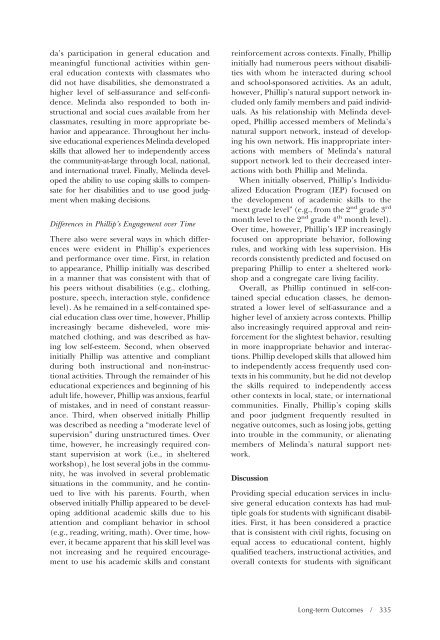Education and Training in Autism and Developmental Disabilities
Education and Training in Autism and Developmental Disabilities
Education and Training in Autism and Developmental Disabilities
Create successful ePaper yourself
Turn your PDF publications into a flip-book with our unique Google optimized e-Paper software.
da’s participation <strong>in</strong> general education <strong>and</strong><br />
mean<strong>in</strong>gful functional activities with<strong>in</strong> general<br />
education contexts with classmates who<br />
did not have disabilities, she demonstrated a<br />
higher level of self-assurance <strong>and</strong> self-confidence.<br />
Mel<strong>in</strong>da also responded to both <strong>in</strong>structional<br />
<strong>and</strong> social cues available from her<br />
classmates, result<strong>in</strong>g <strong>in</strong> more appropriate behavior<br />
<strong>and</strong> appearance. Throughout her <strong>in</strong>clusive<br />
educational experiences Mel<strong>in</strong>da developed<br />
skills that allowed her to <strong>in</strong>dependently access<br />
the community-at-large through local, national,<br />
<strong>and</strong> <strong>in</strong>ternational travel. F<strong>in</strong>ally, Mel<strong>in</strong>da developed<br />
the ability to use cop<strong>in</strong>g skills to compensate<br />
for her disabilities <strong>and</strong> to use good judgment<br />
when mak<strong>in</strong>g decisions.<br />
Differences <strong>in</strong> Phillip’s Engagement over Time<br />
There also were several ways <strong>in</strong> which differences<br />
were evident <strong>in</strong> Phillip’s experiences<br />
<strong>and</strong> performance over time. First, <strong>in</strong> relation<br />
to appearance, Phillip <strong>in</strong>itially was described<br />
<strong>in</strong> a manner that was consistent with that of<br />
his peers without disabilities (e.g., cloth<strong>in</strong>g,<br />
posture, speech, <strong>in</strong>teraction style, confidence<br />
level). As he rema<strong>in</strong>ed <strong>in</strong> a self-conta<strong>in</strong>ed special<br />
education class over time, however, Phillip<br />
<strong>in</strong>creas<strong>in</strong>gly became disheveled, wore mismatched<br />
cloth<strong>in</strong>g, <strong>and</strong> was described as hav<strong>in</strong>g<br />
low self-esteem. Second, when observed<br />
<strong>in</strong>itially Phillip was attentive <strong>and</strong> compliant<br />
dur<strong>in</strong>g both <strong>in</strong>structional <strong>and</strong> non-<strong>in</strong>structional<br />
activities. Through the rema<strong>in</strong>der of his<br />
educational experiences <strong>and</strong> beg<strong>in</strong>n<strong>in</strong>g of his<br />
adult life, however, Phillip was anxious, fearful<br />
of mistakes, <strong>and</strong> <strong>in</strong> need of constant reassurance.<br />
Third, when observed <strong>in</strong>itially Phillip<br />
was described as need<strong>in</strong>g a “moderate level of<br />
supervision” dur<strong>in</strong>g unstructured times. Over<br />
time, however, he <strong>in</strong>creas<strong>in</strong>gly required constant<br />
supervision at work (i.e., <strong>in</strong> sheltered<br />
workshop), he lost several jobs <strong>in</strong> the community,<br />
he was <strong>in</strong>volved <strong>in</strong> several problematic<br />
situations <strong>in</strong> the community, <strong>and</strong> he cont<strong>in</strong>ued<br />
to live with his parents. Fourth, when<br />
observed <strong>in</strong>itially Phillip appeared to be develop<strong>in</strong>g<br />
additional academic skills due to his<br />
attention <strong>and</strong> compliant behavior <strong>in</strong> school<br />
(e.g., read<strong>in</strong>g, writ<strong>in</strong>g, math). Over time, however,<br />
it became apparent that his skill level was<br />
not <strong>in</strong>creas<strong>in</strong>g <strong>and</strong> he required encouragement<br />
to use his academic skills <strong>and</strong> constant<br />
re<strong>in</strong>forcement across contexts. F<strong>in</strong>ally, Phillip<br />
<strong>in</strong>itially had numerous peers without disabilities<br />
with whom he <strong>in</strong>teracted dur<strong>in</strong>g school<br />
<strong>and</strong> school-sponsored activities. As an adult,<br />
however, Phillip’s natural support network <strong>in</strong>cluded<br />
only family members <strong>and</strong> paid <strong>in</strong>dividuals.<br />
As his relationship with Mel<strong>in</strong>da developed,<br />
Phillip accessed members of Mel<strong>in</strong>da’s<br />
natural support network, <strong>in</strong>stead of develop<strong>in</strong>g<br />
his own network. His <strong>in</strong>appropriate <strong>in</strong>teractions<br />
with members of Mel<strong>in</strong>da’s natural<br />
support network led to their decreased <strong>in</strong>teractions<br />
with both Phillip <strong>and</strong> Mel<strong>in</strong>da.<br />
When <strong>in</strong>itially observed, Phillip’s Individualized<br />
<strong>Education</strong> Program (IEP) focused on<br />
the development of academic skills to the<br />
“next grade level” (e.g., from the 2 nd grade 3 rd<br />
month level to the 2 nd grade 4 th month level).<br />
Over time, however, Phillip’s IEP <strong>in</strong>creas<strong>in</strong>gly<br />
focused on appropriate behavior, follow<strong>in</strong>g<br />
rules, <strong>and</strong> work<strong>in</strong>g with less supervision. His<br />
records consistently predicted <strong>and</strong> focused on<br />
prepar<strong>in</strong>g Phillip to enter a sheltered workshop<br />
<strong>and</strong> a congregate care liv<strong>in</strong>g facility.<br />
Overall, as Phillip cont<strong>in</strong>ued <strong>in</strong> self-conta<strong>in</strong>ed<br />
special education classes, he demonstrated<br />
a lower level of self-assurance <strong>and</strong> a<br />
higher level of anxiety across contexts. Phillip<br />
also <strong>in</strong>creas<strong>in</strong>gly required approval <strong>and</strong> re<strong>in</strong>forcement<br />
for the slightest behavior, result<strong>in</strong>g<br />
<strong>in</strong> more <strong>in</strong>appropriate behavior <strong>and</strong> <strong>in</strong>teractions.<br />
Phillip developed skills that allowed him<br />
to <strong>in</strong>dependently access frequently used contexts<br />
<strong>in</strong> his community, but he did not develop<br />
the skills required to <strong>in</strong>dependently access<br />
other contexts <strong>in</strong> local, state, or <strong>in</strong>ternational<br />
communities. F<strong>in</strong>ally, Phillip’s cop<strong>in</strong>g skills<br />
<strong>and</strong> poor judgment frequently resulted <strong>in</strong><br />
negative outcomes, such as los<strong>in</strong>g jobs, gett<strong>in</strong>g<br />
<strong>in</strong>to trouble <strong>in</strong> the community, or alienat<strong>in</strong>g<br />
members of Mel<strong>in</strong>da’s natural support network.<br />
Discussion<br />
Provid<strong>in</strong>g special education services <strong>in</strong> <strong>in</strong>clusive<br />
general education contexts has had multiple<br />
goals for students with significant disabilities.<br />
First, it has been considered a practice<br />
that is consistent with civil rights, focus<strong>in</strong>g on<br />
equal access to educational content, highly<br />
qualified teachers, <strong>in</strong>structional activities, <strong>and</strong><br />
overall contexts for students with significant<br />
Long-term Outcomes / 335

















